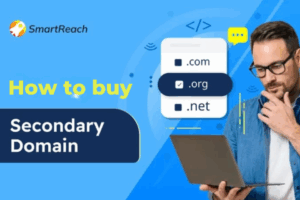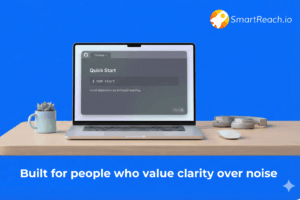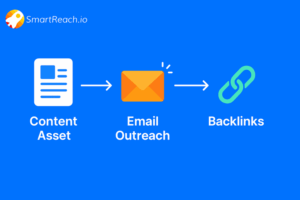What Sales Strategies Actually Work for B2B Teams Today?
The sales landscape is evolving faster than ever. Sales teams everywhere struggle to cut through inbox noise while hitting increasingly aggressive targets. Traditional cold calling yields diminishing returns, and generic mass emails get ignored or flagged as spam. It’s overwhelming, especially when buyer behavior seems to shift constantly.
Here’s the good news: disruption in sales isn’t always negative. In fact, many B2B teams are taking this as an opportunity to grow and close more deals.
Modern buyers actually prefer email outreach, according to Rain Group’s research, 82% of buyers accept meetings with sellers who reach out proactively via email.
This blog will provide you with clear, practical ways to navigate these shifts and succeed in today’s competitive sales environment. Ready for what comes next? Keep reading!
Understanding Sales Disruption as an Opportunity
Change creates room for growth. Sales teams that view market shifts as opportunities to rethink their approach often achieve higher conversion rates than those clinging to outdated tactics.
Instead of dreading changes in buyer behavior, successful teams treat them as signals to adapt and improve their outreach strategy.
Effective sales leaders recognize opportunities during challenging times. They ask, “How can we connect with prospects more effectively today?” Steps like refining email messaging, testing new personalization tactics, or embracing automation tools transform obstacles into competitive advantages.
When cold calling response rates dropped from 10% to under 2%, smart teams didn’t panic, they pivoted to multi-channel outreach combining email, LinkedIn, and targeted content.
Key Strategies for Thriving in Modern Sales
Adapt or fall behind, that’s the harsh reality of today’s competitive B2B landscape. Sales teams excel when they welcome change as their hidden advantage.
Embracing Agility in Sales Processes
Thriving in modern sales requires quick thinking and swift iteration. Sales teams that stay agile can better handle unexpected challenges like inbox algorithm changes or shifts in buyer preferences.
Agility means embracing change without hesitation, whether it’s pivoting your email messaging mid-campaign or testing new outreach channels.
Sales development teams benefit by adopting flexible workflows that adapt to real-time data. If a subject line gets 10% open rates, agile teams test five variations within 48 hours.
If a messaging angle generates low reply rates, they adjust their value proposition immediately. This approach not only improves response rates but also keeps teams ahead of competitors stuck in rigid, one-size-fits-all frameworks.
To know more about ISTT, businesses can explore how adaptable strategies help strengthen long-term sales performance.
Learning from startup sales teams offers practical insights for agility. Many succeed because they adjust quickly based on prospect feedback and engagement metrics.
For example, companies like Gong.io run “Innovation Sprints” where SDRs experiment with unconventional tactics, video emails, personalized memes, or LinkedIn voice messages, then share results in weekly standups.
Similarly, B2B teams must encourage reps to experiment and think creatively without fear of failure.
By fostering adaptability at every level, sales organizations build stronger foundations for long-term revenue growth while confidently navigating market shifts head-on.
Using Sales Automation and Scalable Solutions
Building adaptability paves the way for tools that scale as your outreach grows over time. Sales automation platforms address unique needs that generic email clients can’t, ensuring processes align perfectly with your team’s goals.
Off-the-shelf solutions like Outlook or Gmail lack flexibility for sophisticated campaigns, they miss critical features like automated follow-up sequences, CRM integration, and deliverability monitoring, leaving gaps in campaign effectiveness.
While basic email tools work for one-off messages, they can’t handle the complexity of modern B2B outreach. Custom automation addresses this gap.
Platforms built specifically for sales engagement allow teams to send 500+ personalized emails daily without triggering spam filters. They automate repetitive tasks, follow-ups, CRM updates, lead scoring, freeing reps to focus on high-value activities like discovery calls and demos.
Systems that adjust to growth can meet increasing demands without disrupting workflows. For instance, a team of 5 SDRs might start with simple sequences, then scale to 50 reps running A/B tests across multiple campaigns.
Sales automation platforms incorporate these capabilities smoothly into daily operations. Teams save time, reduce manual errors, and improve conversion rates by choosing the right approach suited to their growth trajectory. Providers like IP Services for Portland companies specialize in aligning scalable solutions with local business needs, ensuring efficiency as demands evolve.
Prioritizing Innovation in Your Sales Strategy
Encourage sales reps to propose new outreach tactics and messaging approaches. Organize regular brainstorming sessions or “cold email challenges” to maintain creativity. Acknowledge contributions openly, regardless of their size, even failed experiments provide valuable learning opportunities.
Equip teams with the resources they need to experiment confidently. Offer training on emerging tactics (video emails, personalized landing pages), dedicated time for testing new approaches, and access to tools for A/B testing. Sales leaders should set an example by staying curious about unconventional outreach methods and receptive to data-driven insights.
Here are five innovative cold email tactics worth testing:
- Personalized video thumbnails in emails (increases open rates by 20-30%)
- Trigger-based sequences that respond to prospect behavior (clicked link, visited pricing page)
- Problem-first messaging that leads with pain points, not product features
- Micro-personalization at scale using AI to customize opening lines based on LinkedIn data
- Multi-channel orchestration where email, LinkedIn, and phone touchpoints work together
The best sales teams treat outreach as an ongoing experiment. They test, measure, learn, and iterate, knowing that a 60% success rate is excellent in sales prospecting.
The Role of Emerging Technologies in Sales
Emerging technologies are transforming how B2B teams connect with prospects and close deals.
Let’s examine how they can shape your sales strategy.
Artificial Intelligence and Machine Learning in Sales Engagement
AI and machine learning automate repetitive sales tasks, freeing reps to focus on relationship-building and closing deals.
For example, predictive lead scoring helps sales teams prioritize prospects most likely to convert based on engagement patterns, job title, company size, email opens, link clicks, and LinkedIn activity.
These tools identify patterns in massive datasets that humans might overlook, enabling decision-making to become faster and more accurate.
AI-powered email personalization goes beyond simple merge tags. Modern platforms analyze thousands of successful campaigns to suggest optimal subject lines, opening sentences, and call-to-action phrasing for each prospect segment.
For instance, emails sent to CFOs might emphasize ROI metrics, while emails to VPs of Sales focus on efficiency gains. Machine learning algorithms consistently refine themselves with new data, improving recommendations over time.
Send-time optimization represents another breakthrough. Instead of sending all emails at 9 AM, AI analyzes each recipient’s past engagement behavior to predict when they’re most likely to open and reply.
This can increase open rates by 20-30% without changing email content at all. Similarly, automated A/B testing runs continuously in the background, testing subject line variations and recommending winners based on statistical significance.
Reply sentiment analysis powered by AI helps sales teams prioritize responses. Not all replies are created equal, “Thanks, not interested” requires different handling than “Can you send more info?” AI categorizes responses automatically, routing high-intent prospects to senior reps while filtering out polite rejections.
Such advancements directly influence how B2B teams operate. Rather than manually segmenting lists, writing individual emails, or guessing optimal send times, sales professionals leverage AI to work smarter.
The technology handles the repetitive analysis and optimization, while humans focus on crafting compelling value propositions and building authentic relationships.
Multi-Channel Sales Intelligence and Connected Data
Modern B2B sales require visibility across multiple touchpoints. When a prospect visits your pricing page, opens three emails in a week, and views your LinkedIn profile all within the same timeframe, that’s a strong buying signal.
Sales intelligence platforms integrate data from email engagement, website visits, LinkedIn interactions, and CRM notes to build a complete picture of prospect behavior.
Connected systems enhance decision-making by delivering real-time insights. Sales teams can observe which prospects are actively researching solutions through email click tracking and website analytics.
These tools assist in identifying high-intent buyers while reducing time wasted on unqualified leads. For example, a prospect who opens every email, clicks multiple links, and visits your pricing page twice is demonstrating more intent than someone who hasn’t engaged in 30 days.
Email engagement triggers can automatically initiate LinkedIn outreach. If a prospect opens an email but doesn’t reply, the system might prompt an SDR to send a personalized LinkedIn connection request.
If they click a case study link, the system could trigger a follow-up email with a related resource. This orchestration across channels creates a cohesive experience for prospects while keeping sales reps focused on the right activities at the right time.
The key is integration. When your email platform, CRM, LinkedIn automation tool, and website analytics communicate seamlessly, you gain the connected intelligence needed to move deals forward efficiently.
Email Deliverability Technology: Reaching the Inbox
The most sophisticated AI-written email means nothing if it lands in spam. Email deliverability technology has evolved significantly, from basic authentication to complex sender reputation algorithms.
Modern sales platforms use AI to predict spam risk before sending, automatically adjusting sending patterns to maintain inbox placement.
Understanding the fundamentals matters.
- SPF (Sender Policy Framework) verifies that emails come from authorized servers.
- DKIM (DomainKeys Identified Mail) adds a digital signature to prove emails haven’t been tampered with.
- DMARC (Domain-based Message Authentication, Reporting & Conformance) tells receiving servers what to do with emails that fail authentication. Together, these three protocols form the foundation of email security and deliverability.
But authentication is just the beginning. Internet service providers (ISPs) monitor sender behavior patterns, sudden spikes in volume, high bounce rates, or spam complaints can damage your domain reputation.
This is why email warm-up strategies matter. Rather than immediately sending 1,000 cold emails from a new domain, smart teams gradually increase volume over 2-4 weeks, starting with 20-30 emails daily and slowly ramping up as their sender reputation builds.
AI-powered deliverability tools monitor your sender score in real-time, alerting teams before problems escalate. They analyze bounce rates, spam complaints, and engagement metrics to recommend adjustments.
For example, if your emails to a certain domain consistently bounce, the system might suggest removing that domain from future campaigns or verifying email addresses more thoroughly.
Domain reputation monitoring helps teams maintain consistent inbox placement. One spam complaint can tank deliverability for weeks, so platforms increasingly include built-in safeguards, automatic unsubscribe links, list cleaning to remove invalid addresses, and engagement-based sending that prioritizes recipients who’ve opened recent emails.
Companies recovering from spam folder placement often follow a systematic approach: audit authentication records, clean email lists, reduce sending volume temporarily, focus on highly engaged segments, and gradually rebuild reputation over 30-60 days. The key is patience, rushing the recovery process usually makes things worse.
Building Resilience Through Market Changes
Strong sales organizations face change with determination and strategic planning. They build systems that adapt and scale, not collapse, under pressure.
Developing a Future-Proof Sales Stack
Creating a long-lasting sales strategy starts with choosing the right technology foundation. Sales teams must keep up with shifting buyer preferences and market conditions.
For example, implementing agile decision-making processes helps teams adjust to sudden changes in prospect behavior or competitive landscape. Leaders should also allocate resources specifically for experimenting with new tools and tactics without disrupting core revenue-generating activities.
Technology serves as the backbone of any resilient sales operation. Teams can remain competitive by integrating essential tools that work together seamlessly:
The Core Four Tools Every B2B Team Needs:
- Sales Engagement Platform – Automates email sequences, tracks engagement, and manages follow-ups (e.g., SmartReach.io, Outreach, SalesLoft)
- CRM System – Centralizes prospect data and tracks deal progress (e.g., Salesforce, HubSpot, Pipedrive)
- Data Enrichment Tool – Provides accurate contact information and firmographic data (e.g., ZoomInfo, Apollo, Clearbit)
- LinkedIn Automation – Enables social selling and multi-channel outreach (e.g., Sales Navigator, LinkedIn helper tools)
The key is integration. When these four categories communicate seamlessly, data flows automatically, email engagement updates CRM records, LinkedIn connections trigger email sequences, and enrichment tools populate missing contact details.
This eliminates manual data entry and ensures reps always have complete context when reaching out.
Combining automation with human oversight ensures tasks are completed faster without losing quality. Automation handles repetitive work (sending follow-ups, logging activities, scoring leads), while humans focus on strategic thinking (crafting compelling messaging, building relationships, negotiating deals).
These steps not only support long-term revenue growth but also reduce risks tied to unpredictable market disruptions.
Future-Proofing Your Stack:
Buy platforms, not point solutions. Choose tools that integrate well and have robust API ecosystems. Avoid the temptation to adopt every new tool, tech stack bloat creates confusion and fragmentation.
Instead, select vendors with proven track records and active development roadmaps. Reevaluate your stack annually, but avoid constant switching, consistency allows teams to build expertise and optimize workflows over time.
Balancing Technology with Human Connection
Focusing solely on automation can alienate the very buyers you’re trying to reach. Sales teams need to create outreach experiences that feel personal, not robotic.
For instance, using dynamic personalization variables (prospect’s company name, recent LinkedIn post, shared connection) ensures emails feel relevant rather than mass-produced.
AI can draft initial email copy, but humans must review and refine it. Buyers can detect generic, AI-generated language, it lacks authenticity and emotional intelligence. The best approach combines technology’s efficiency with human judgment and creativity.
Use automation to handle logistics (scheduling, follow-ups, data entry) while reserving human touchpoints for high-value interactions (discovery calls, objection handling, negotiation).
Investing in sales training bridges the gap between rapid tech adoption and team preparedness. Reps need training on how to use new tools effectively, but also on fundamental skills, active listening, questioning techniques, and consultative selling.
This approach keeps morale high while reducing resistance to change. When teams understand that automation makes their jobs easier (not obsolete), adoption accelerates.
Meanwhile, maintaining ethical practices in prospecting builds trust with buyers. This means respecting unsubscribe requests immediately, being transparent about how you obtained contact information, and avoiding deceptive subject lines or sender names. Trust drives long-term relationships, and relationships drive revenue.
Conclusion
Thriving in modern sales means embracing change strategically. Market disruption can inspire growth when paired with the right mindset, tools, and processes.
By staying agile, leveraging automation intelligently, and experimenting with emerging tactics, B2B teams can turn challenges into competitive advantages.
The future belongs to sales professionals who see opportunity in every shift, whether it’s a new AI capability, a change in buyer behavior, or an untested outreach channel. Keep moving forward, keep testing, and keep learning. Because in sales, standing still isn’t an option anymore.
FAQ: Modern Sales Strategies
Q: What is sales automation and how does it help B2B teams?
A: Sales automation software handles repetitive tasks like follow-up emails, CRM updates, and engagement tracking. It frees sales reps to focus on high-value activities like discovery calls and demos, increasing productivity by 30-40% and enabling 3-5 more conversations weekly.
Q: How can AI improve cold email response rates?
A: AI improves response rates through predictive lead scoring, send-time optimization (20-30% better opens), personalized subject line suggestions, and automated A/B testing. It identifies which prospects to contact, when to reach them, and what messaging resonates best.
Q: What’s the difference between sales engagement platforms and regular email?
A: Sales engagement platforms offer automated sequences, CRM integration, deliverability monitoring, A/B testing, engagement tracking, and team analytics. Regular email clients like Gmail lack these features and can’t efficiently manage personalized outreach to 100+ prospects simultaneously.
Q: How do you avoid spam filters with cold email?
A: Authenticate your domain with SPF, DKIM, and DMARC. Warm up new domains gradually (start with 20-30 daily emails). Maintain high engagement with personalized, relevant content. Avoid spam trigger words and always include unsubscribe links.
Q: What metrics should sales teams track for email campaigns?
A: Track delivery rate, open rate, click-through rate, reply rate, and conversion rate. Advanced metrics include bounce rate, unsubscribe rate, time-to-reply, and reply sentiment. Reply rate (5-10% is excellent) matters most for cold outreach success.
Q: How often should you follow up with cold email prospects?
A: Best practice is 7 touches over 14-21 days. Research shows 80% of sales require five or more follow-ups. Space emails strategically: Days 1, 3, 7, 10, 14, 17, and 21 work well for most B2B sales cycles.
Q: Should sales teams use multi-channel outreach or stick to email only?
A: Multi-channel outreach (email + LinkedIn + phone) outperforms email-only by 2-3x. Coordinate messaging across channels rather than spamming everywhere. Start with optimized email, then layer in LinkedIn and phone touchpoints strategically based on target personas.
Q: What is email warm-up and why does it matter?
A: Email warm-up gradually builds sender reputation for new domains by starting with low volume (20-30 daily emails) and increasing over 2-4 weeks. It prevents spam folder placement and protects long-term domain reputation before launching full campaigns.



